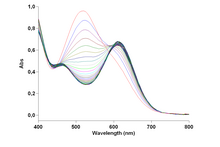 | |
| Identifiers | |
|---|---|
| CAS Number | |
| 3D model (JSmol) | |
| ChemSpider | |
| PubChem CID | |
InChI
| |
SMILES
| |
| Properties | |
| Chemical formula | C4H16Cl3CoN4 |
| Molar mass | 285.48 g·mol |
| Appearance | violet solid |
| Melting point | decomposes |
| Solubility in water | good |
| Hazards | |
| GHS labelling: | |
| Pictograms | 
|
| Signal word | Warning |
| Hazard statements | H315, H319, H335 |
| Precautionary statements | P261, P264, P271, P280, P302+P352, P304+P340, P305+P351+P338, P312, P321, P332+P313, P337+P313, P362, P403+P233, P405, P501 |
| Except where otherwise noted, data are given for materials in their standard state (at 25 °C , 100 kPa).
| |
cis-Dichlorobis(ethylenediamine)cobalt(III) chloride is a salt with the formula Cl (en = ethylenediamine). The salt consists of a cationic coordination complex and a chloride anion. It is a violet diamagnetic solid that is soluble in water. One chloride ion in this salt readily undergoes ion exchange, but the two other chlorides are less reactive, being bound to the metal center.
Synthesis and optical resolution
Cis-dichlorobis(ethylenediamine)cobalt(III) chloride is obtained by heating a solution of trans-dichlorobis(ethylenediamine)cobalt(III) chloride, e.g. using a steam bath.
The racemate can be resolved into two enantiomers (Λ and Δ) by the formation of the d-α-bromocamphor-π-sulfonate salt. The diastereomeric salts are separated by recrystallization. After their purification, the individual diastereomers are converted back to the chloride salt by reaction with ice cold hydrochloric acid.

Related complexes
This salt is less soluble than its dull-green isomer trans-dichlorobis(ethylenediamine)cobalt(III) chloride. This pair of isomers were significant in the development of the area of coordination chemistry. The chiral cis isomer is obtained by heating the trans isomer. Both isomers of dichlorobis(ethylenediamine)cobalt(III) have often been used in stereochemical studies.
Tris(ethylenediamine)cobalt(III) chloride in contrast to the bis(ethylenediamine) complexes does not undergo substitution.
References
- "575909". sigma. Retrieved 15 December 2021.
- John C. Bailar, Jr. (1946). "Cis - and trans -Dichlorobis-(ethylenediamine)cobalt(III) Chloride and the Resolution of the cis Form". Cis- and Trans-Dichlorobis-(Ethylenediamine)Cobalt(III) Chloride and the Resolution of the Cis Form. Inorganic Syntheses. Vol. 2. pp. 222–225. doi:10.1002/9780470132333.ch71. ISBN 9780470132333.
- Jörgensen, S.M. "Ueber Metalldiaminverbindungen" J. prakt. Chem. (in German), 1889, volume 39, page 8. doi:10.1002/prac.18890390101

